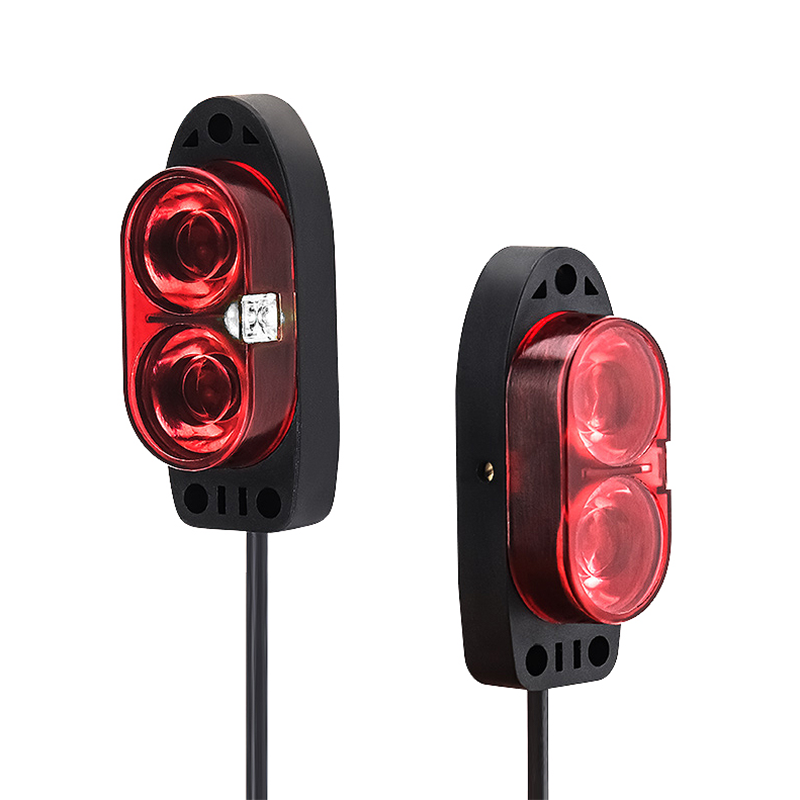To install a Photoelectric switch correctly is crucial for ensuring its optimal performance. Proper installation enhances accuracy, maintains safety, and extends the lifespan of the switch. Every detail matters during the process, as even a minor mistake can result in poor functionality or potential damage. By dedicating time to install a photoelectric switch properly, you can prevent unnecessary problems and maximize the device's efficiency. Whether you're new to this or have prior experience, correct installation is essential for achieving the best results.
Tools and Materials Needed
Before you install a photoelectric switch, gather the right tools and materials. Having everything ready will save time and ensure a smooth installation process. Let’s break it down into essential tools and required materials.
Essential Tools
Screwdrivers and wrenches
You’ll need screwdrivers and wrenches to secure the switch and its mounting brackets. These tools help tighten screws and bolts, ensuring the switch stays firmly in place. Choose the right size to avoid damaging the hardware.
Wire strippers and cutters
Wire strippers and cutters are crucial for preparing electrical wires. Use them to strip insulation and cut wires to the correct length. This ensures clean and secure connections during the wiring process.
Multimeter for testing
A multimeter helps you test electrical connections and verify voltage levels. Use it to check if the power supply matches the switch’s requirements. This step ensures safety and prevents potential damage to the switch.
Required Materials
Photoelectric switch
The photoelectric switch is the centerpiece of this installation. Choose a high-quality switch that suits your specific Application. Check the manufacturer’s guide for compatibility with your system.
Mounting brackets or hardware
Mounting brackets or hardware secure the switch in its designated position. These components keep the switch stable and aligned for optimal performance. Ensure they are sturdy and compatible with the switch model.
Electrical wiring and connectors
Electrical wiring and connectors link the switch to the power source and load. Use wires of the appropriate gauge and high-quality connectors to ensure reliable connections. Poor-quality wiring can lead to malfunctions or safety hazards.
Weatherproof enclosure (if required)
If the switch will be exposed to harsh weather conditions, use a weatherproof enclosure. This protects the switch from moisture, dust, and extreme temperatures. A well-protected switch lasts longer and performs better.
By gathering these tools and materials, you’ll set yourself up for a successful installation. Each item plays a vital role in ensuring the switch operates efficiently and safely.
Pre-Installation Safety Checks
Before you install a photoelectric switch, take a moment to ensure everything is safe and ready. Skipping safety checks can lead to accidents or poor performance. Follow these steps to create a secure and efficient setup.
Power Supply Safety
Ensure the power is turned off before starting.
Always turn off the power supply before you begin. This step protects you from electrical shocks and prevents damage to the switch. Use a multimeter to confirm there’s no live current in the wires. Never assume the power is off—double-check for your safety.
Verify the voltage compatibility of the switch.
Check the voltage requirements of the photoelectric switch. Compare them with your power supply to ensure they match. Using an incompatible voltage can damage the switch or cause it to malfunction. Refer to the manufacturer’s guide for the correct specifications.
Environmental Considerations
Check for dust, moisture, or extreme temperatures that may affect performance.
Inspect the installation area for environmental factors. Dust and moisture can interfere with the sensor’s accuracy. Extreme temperatures might reduce the switch’s lifespan. If the location isn’t ideal, consider using a weatherproof enclosure to protect the switch.
Ensure the installation area is free of obstructions and artificial light sources.
Look around the area where you’ll install the switch. Remove any objects that could block the sensor’s view. Artificial light sources, like streetlights or lamps, can confuse the sensor. Choose a spot with minimal interference for the best results.
Positioning the Switch
Orient the switch to face North for optimal performance.
Position the switch so it faces North. This orientation reduces the impact of direct sunlight, which can affect the sensor’s accuracy. A clear view of the North ensures the switch operates efficiently throughout the day.
Ensure the lens and nipple are watertight to prevent moisture ingress.
Inspect the lens and nipple of the switch. Make sure they’re sealed tightly to keep out moisture. Water can damage the internal components and reduce the switch’s performance. If needed, apply a waterproof sealant for extra protection.
By completing these pre-installation safety checks, you’ll set the stage for a smooth and successful installation. These steps not only protect you but also ensure the switch performs at its best in any environment.
Step-by-Step Installation Process
Installing a photoelectric switch requires careful attention to detail. Follow these steps to ensure the process is smooth and effective.
Wiring the Photoelectric Switch
Identify the wiring terminals (power, load, and ground).
Start by locating the wiring terminals on the photoelectric switch. These terminals are usually labeled as power, load, and ground. Refer to the manufacturer’s manual if you’re unsure about their placement. Identifying these correctly is essential for proper wiring and functionality.
Connect the wires according to the manufacturer’s instructions.
Once you’ve identified the terminals, connect the wires as instructed in the manual. Use wire strippers to prepare the wires and ensure clean connections. Attach the power wire to the power terminal, the load wire to the load terminal, and the ground wire to the ground terminal. Double-check each connection to avoid errors that could lead to malfunctions.
Mounting the Switch
Secure the switch using the provided brackets or hardware.
Take the mounting brackets or hardware included with your switch and secure it firmly in place. Use a screwdriver or wrench to tighten the screws or bolts. A stable mount prevents the switch from shifting or vibrating, which could affect its performance.
Position the switch at the correct height and angle.
Choose a height and angle that allow the switch to function optimally. The sensor should have a clear line of sight to its target area. Avoid placing it too high or too low, as this could interfere with its ability to detect objects accurately. Adjust the angle to ensure the sensor faces the intended direction.
Aligning the Sensor
Adjust the emitter and receiver for proper alignment.
If your photoelectric switch has separate emitter and receiver units, align them carefully. The emitter sends out the light beam, and the receiver detects it. Misalignment can cause detection issues. Use a level or alignment tool to ensure they are perfectly aligned.
Use the indicator light (if available) to confirm alignment.
Many photoelectric switches come with an indicator light to help you confirm proper alignment. Turn on the power and observe the light. If it’s steady or blinking as per the manual’s instructions, the alignment is correct. If not, make small adjustments until the light indicates proper alignment.
By following these steps, you’ll successfully install the photoelectric switch and set it up for optimal performance. Taking the time to wire, mount, and align the switch correctly ensures it operates efficiently and reliably in its environment.
Testing and Adjustments
After you install a photoelectric switch, testing and making adjustments are essential steps. These ensure the switch operates as intended and performs optimally in its environment. Let’s walk through the process.
Initial Power-On Test
Turn on the power and check for proper operation.
Once the installation is complete, restore the power supply. Observe the switch as it powers on. Check if the indicator light or any other signal confirms that the device is functioning. If the switch doesn’t respond, revisit the wiring connections and verify they match the manufacturer’s instructions.
Verify the sensor detects objects as intended.
Test the sensor by placing an object within its detection range. Watch how the switch reacts. It should detect the object and trigger the connected load, such as a light or motor. If the sensor fails to respond, inspect the alignment and ensure there are no obstructions or environmental factors interfering with its performance.
Fine-Tuning Adjustments
Adjust sensitivity settings for optimal detection.
Most photoelectric switches allow you to adjust their sensitivity. Locate the sensitivity control, often a dial or button, and fine-tune it based on your needs. Increase the sensitivity if the sensor struggles to detect objects. Lower it if the sensor reacts to irrelevant movements or objects. Make small adjustments and test after each change to find the perfect balance.
Recheck alignment and make minor corrections if needed.
Alignment plays a critical role in the switch’s accuracy. Double-check the positioning of the emitter and receiver. Use the indicator light or alignment tools to confirm they are perfectly aligned. If necessary, make slight adjustments to improve detection. Even a small misalignment can impact the switch’s performance, so take your time to get it right.
Testing and adjustments are the final steps to ensure your photoelectric switch works efficiently. By carefully following these steps, you’ll maximize the switch’s performance and reliability in its environment.
Maintenance Tips for Longevity
Proper maintenance ensures your photoelectric switch operates efficiently for years. By dedicating time to regular upkeep, you can avoid performance issues and extend the device's lifespan. Here are some practical tips to keep your switch in top condition.
Regular Cleaning
Remove dust and debris from the sensor lens.
Dust and debris can accumulate on the sensor lens over time, reducing its accuracy. Check the lens periodically and clean it when needed. A clear lens ensures the sensor detects objects without interference.
Use a soft cloth and avoid abrasive materials.
When cleaning the lens, use a soft, lint-free cloth. Avoid abrasive materials or harsh chemicals, as they can scratch or damage the surface. Gentle cleaning preserves the lens and keeps the sensor functioning properly.
Periodic Testing
Test the switch periodically to ensure consistent performance.
Regular testing helps you confirm that the switch is working as intended. Activate the switch and observe its response. If it fails to detect objects or triggers inconsistently, investigate the issue immediately.
Inspect wiring and connections for wear or damage.
Examine the wiring and connections during your routine checks. Look for frayed wires, loose connections, or signs of corrosion. Address any issues promptly to prevent malfunctions or safety hazards.
Recalibration
Regularly check the sensor's alignment and recalibrate if necessary.
Over time, the alignment of the sensor may shift due to environmental factors or vibrations. Check the alignment regularly and recalibrate it if needed. Proper alignment ensures the switch maintains its accuracy and reliability.
By following these maintenance tips, you’ll keep your photoelectric switch in excellent condition. Regular cleaning, testing, and recalibration not only enhance performance but also extend the life of the device. Whether you’re new to maintaining these switches or have experience, these steps will help you get the most out of your installation.
By following the step-by-step process, you ensure the proper installation of your photoelectric switch and achieve its optimal performance. Regular testing keeps it functioning as expected, while cleaning and recalibration maintain its accuracy and extend its lifespan. Always rely on the manufacturer’s manual for specific guidance tailored to your device. Taking these steps not only enhances the switch’s efficiency but also saves you time and effort in the long run. With the right approach, you’ll get the most out of your installation.

